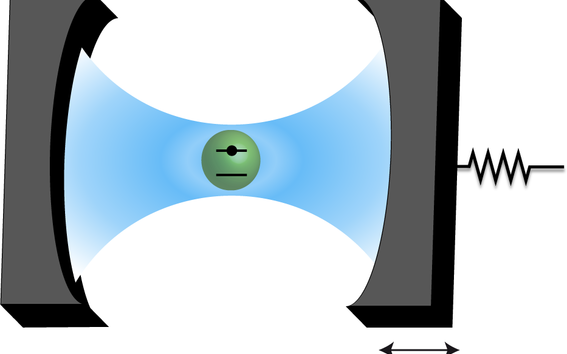When mediated by superconductivity, light pushes matter million times more

Radiation pressure can be increased considerably with the help of a small superconducting island, as was revealed by the joint research done in the Aalto University and the Universities of Jyväskylä and Oulu. The results of the research were published in Nature Communications in April.
The finding paves a way for the studies of mechanical oscillations at the level of a single photon, the quantum of light. The research enables the observation of quantum phenomena in larger structures than before. Thus, it allows studying the validity of the quantum mechanical laws in large structures. Some claim that the theory holds only with very small particles. Nevertheless, the existence of an upper limit for the validity region has not been found - yet.
Light can be confined to reflect back and forth between two mirrors. If one of the mirrors is mounted with a spring, the kicks of the light photons can affect the vibrations of the mirror. Now researchers have been able to amplify the kicks of the photons by circulating them through a superconducting quantum system (green).
In their work the researchers combine knowledge on experimental and theoretical physics, and show how the strength of the radiation pressure coupling can be considerably increased. They placed a superconducting island in between the electromagnetic field and the oscillator to mediate the interaction.
- In the measurements, we exploited the Josephson coupling of the superconducting junctions, especially its nonlinear character, explains Juha Pirkkalainen from Aalto University, the post-doctoral researcher who conducted the measurements.
- With the superconducting island, the radiation pressure increased a millionfold the value we had previously achieved, reports the supervisor of the experimental group, professor Mika Sillanpää from Aalto University.
Because of the increased radiation pressure coupling, the oscillator observes the electromagnetic field with the precision of a single photon. Correspondingly, the oscillators reveal themselves to the field with the resolution of a single quantum of oscillations, a phonon.
- Such strong coupling allows, in principle, the measurement of quantum information from an oscillator nearly visible to the naked eye, explains professor Tero Heikkilä from the University of Jyväskylä who was in charge of the theoretical studies.
In our everyday lives, the effects of the radiation pressure of light can be neglected. Your furniture is not moved over even though the light, or more generally the electromagnetic radiation, emitted by your lamps bounces off from its surfaces thus creating a radiation pressure force.
An ordinary 100 Watt light-bulb causes a radiation pressure that is only a trillionth (one part to 1000000000000) of the normal atmospheric pressure. Nevertheless, in space the relevance of the phenomenon becomes apparent: because of the radiation pressure the tails of comets typically point away from the Sun. Radiation pressure has also been proposed as the propulsion for the solar sails.
The research was conducted within the Academy of Finland Center of Excellence on Low Temperature Quantum Phenomena and Devices and it was supported by the European Research Council.
Read the Nature Communications article: Cavity optomechanics mediated by a quantum two-level systemJ.-M. Pirkkalainen, S.U. Cho, F. Massel, J. Tuorila, T.T. Heikkilä, P.J. Hakonen, and M.A. Sillanpää.
Additional information:
Prof. Mika Sillanpää, [email protected], +358 50 344 7330
Department of Applied Physics, Aalto University
Prof. Tero Heikkilä, [email protected], +358 40 805 4804
Department of Physics and Nanoscience Center, University of Jyväskylä
- Published:
- Updated:
Read more news

Get to know us: Associate Professor Maria Sammalkorpi
Sammalkorpi received her doctorate from Helsinki University of Technology 2004. After her defence, she has worked as a researcher at the Universities of Princeton, Yale and Aalto.
Aalto computer scientists in ICML 2024
Computer scientists in ICML 2024
Getting bacteria into line
Physicists use magnetic fields to manipulate bacterial behaviour